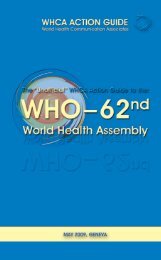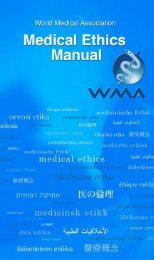the basics - World Health Communication Associates
the basics - World Health Communication Associates
the basics - World Health Communication Associates
- No tags were found...
You also want an ePaper? Increase the reach of your titles
YUMPU automatically turns print PDFs into web optimized ePapers that Google loves.
people must locate health information, evaluate <strong>the</strong> information for credibilityand quality and analyse risks and benefits. Fur<strong>the</strong>rmore, people must be able askpertinent questions and express health concerns clearly by describing symptoms inways <strong>the</strong> providers can understand (IOM 2004).Moreover, people are increasingly challenged to make sound health decisionsin many contexts of daily life. For example, <strong>the</strong>y have to read and understand productlabels and warnings; make lifestyle choices about food, activity, cigarettes and drugs;and evaluate <strong>the</strong> safety of chemicals in products <strong>the</strong>y buy. Such decision makingrequires an understanding of <strong>the</strong> benefits of being healthy and information aboutpersonal health issues. All of <strong>the</strong>se everyday demands require people to be ableto assess <strong>the</strong>ir current health and consider and deal with <strong>the</strong> many socioeconomicfactors and cultural values that influence it. For all this <strong>the</strong>y need to have healthliteracy competencies that allow <strong>the</strong>m to take responsibility for <strong>the</strong>ir own and <strong>the</strong>irfamily’s—and, where necessary, <strong>the</strong>ir community’s—health (Kickbusch & Maag2008).Finally, many people use alternative <strong>the</strong>rapies. This includes traditional healingapproaches, nutritional supplements, acupuncture, homeopathy and a wide varietyof o<strong>the</strong>r <strong>the</strong>rapeutic and healing techniques. The estimated global market for suchinterventions equals or exceeds allopathic health care markets in many countries.The need to make choices between alternative approaches and standard medical carecreates fur<strong>the</strong>r challenges.Community participationCommunity participation aims to identify, shape and advance shared interests inpriority issues for community health. This might be investment in education forself-care, increased penetration of vaccinations, elimination of vectors and control ofsexually transmitted diseases. Investment in such participatory health literacy skilldevelopment can help individuals use systems more effectively and also serve ascatalysts for change, when needed, within systems (IOM 2004).SECTION 4: WHAT CAN WE DO TO STRENGTHEN HEALTH LITERACY? 51






